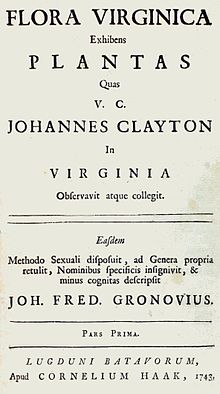John Clayton (botanist)
John Clayton (* 1694 in Fulham , England, † December 15, 1773 in Gloucester, Virginia) , was a British-North American botanist . Its official botanical author abbreviation is " J.Clayton "; earlier the abbreviation “ Clayt. " in use.
Life
John Clayton was born in the autumn of 1694 as the son of lawyer John Clayton Sr. (1665–1737) and his wife, Ann Page, were born in Fulham, Middlesex . His father emigrated from England to Virginia on August 11, 1705 and was appointed Attorney General of the colony in 1713 . After John Jr. Having completed his legal training in England, he also moved to Virginia in 1715. On October 20, 1720, he was appointed Clerk of the County of Gloucester, an office he held until his death. He lived in what was known as Windsor House in Ware Parish, Gloucester County, Virginia. In addition to his official activities, he ran a tobacco plantation of 150 hectares. On January 22, 1723 he married Elizabeth Whiting (1700–1771). Their marriage had eight children.
Since the name John is common in the widely ramified Clayton family, there is confusion in many biographical notes and therefore incorrect information about the year of birth or death.
The researcher
In his new home, Clayton works intensively with the little-explored flora of the North American continent. In close contact with like-minded people, he collects and classifies the plants of Virginia, especially the area between the James River and the Rappahannock River . He begins an extensive correspondence with botanists in Europe. His circle of friends includes Jane Colden , John Bartram , the London textile merchant Peter Collinson (1694–1768), Pehr Kalm and Carl von Linné . Clayton's hard work and helpfulness are rewarded by Benjamin Franklin with the privilege of having his mail, including extensive collections of herbarized plants , delivered free of charge.
When his friend, the naturalist Mark Catesby , with whom he had made several excursions through Virginia, returned permanently to Oxford , Clayton sent him to England in 1734 and 1735 almost all of the plants he had collected in Virginia. Catesby passes the collection on to Jan Frederik Gronovius in Holland, as he himself does not know many of the species. For his part, Gronovius asked for help from the young Carl von Linné, who was a guest researcher with George Clifford (1685–1760) in Hartekamp near Haarlem between 1735 and 1737 .
While Clayton waits for the results of the determination, he is working on a Virginia plant directory. He sorts the species according to the system of John Ray . He sends the manuscript to Catesby with the request to find a publisher in England. This manuscript also reaches Gronovius. With the help of Linnaeus, he rearranged the plants according to his system and published the work in 1739 as Flora Virginica . In it, Gronovius disregards Clayton's name creations and gives his own names or takes Linné's suggestions for naming. In the same way, a second volume of Flora Virginica was made in 1742 .
Services
While Clayton's achievements were largely underestimated during his lifetime, his importance for botanical research is now recognized in professional circles. A large part of Linnaeus' knowledge of North American flora is based on the plants that Clayton had collected. Many of them are nomenclatural types , that is, it is the specimens from which Gronovius and Linné made the first scientific descriptions . The Flora Virginica , which could not have come into being without Clayton's diligence and care, was one of the fundamental scientific representations of the flora of North America. For half a century it remained the most important standard work on the subject. Clayton's plan to write a book about the flora of Virginia himself could no longer be realized because a fire destroyed the Gloucester County House and its private barn. Only the documents he sent to Europe have been preserved. They were bought by Sir Joseph Banks in 1793 and so came to the British Museum in London (now the Natural History Museum), where they are now kept as a separate collection ("Clayton Collection").
Honors
Linnaeus paid tribute to Clayton by naming the genus Claytonia (plate herb) as a souvenir. In the course of the following decades, around 20 other plant species were named after Clayton.
The memory of Clayton is also cherished by the Arkansas Native Plant Society , which publishes a magazine called Claytonia .
literature
- Edmund Berkeley & Dorothy Smith Berkeley: John Clayton, Pioneer of American Botany . University of North Carolina Press 1963.
- Johann Friedrich Gronovius: Flora Virginica . Suffer. I: 1739; II: 1743.
- Johann Friedrich Gronovius: Flora Virginica . 2nd edition Leiden, 1762.
Individual evidence
- ↑ Robert Zander : Zander hand dictionary of plant names. Edited by Fritz Encke , Günther Buchheim, Siegmund Seybold . 13th, revised and expanded edition. Eugen Ulmer, Stuttgart 1984, ISBN 3-8001-5042-5 .
Web links
- Correspondence between John Clayton and Carl von Linné
| personal data | |
|---|---|
| SURNAME | Clayton, John |
| BRIEF DESCRIPTION | British-American botanist |
| DATE OF BIRTH | 1694 |
| PLACE OF BIRTH | Fulham Middlesex , England |
| DATE OF DEATH | December 15, 1773 |
| Place of death | Gloucester County (Virginia) |
